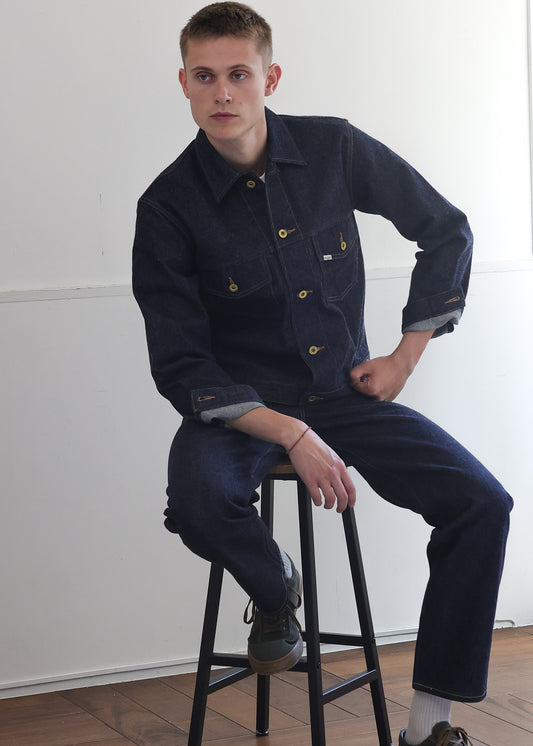Denim jeans after 7 years of planning
Designer Hironori Kawanami, who previously worked with the Japanese denim brand FULLCOUNT, shares the story behind the WASEW brand’s first denim setup, launched in 2022 after a seven-year journey. Each time he approached the denim, he found himself caught in the depths of his own perfectionism, unable to move forward. This struggle stemmed from his deep understanding of denim. Now, speaking not just as a designer but as a true denim enthusiast, Kawanami has talked about WASEW’s first-ever jeans, the ‘Lot 0110 TYPE STRAIGHT'.

Learning from vintage, a new take on left-hand twill denim
【By: Hironori Kawanami】
This project began with the idea of creating WASEW’s original left-hand twill denim, inspired by a 1944 Lee 101B that I personally own. It took seven years, but with the help of many people, I was able to bring my vision of the perfect denim to life.
The first pair of jeans I consciously wore was the Lee 101B, which had a significant impact on how I view denim. I still wear them occasionally, and they remain a key item in my roots as a designer.
Using the Lee 101B as a base, I aimed to improve elements that didn’t fit modern times or could be better. I’d like to share the entire journey with you.

The Japanese Indigo Blue
To find the perfect shade of indigo blue, I made countless trips to Ibara and Kojima in Okayama. It wasn’t just about finding the right fabric—it was about finding the right thread, dye, and weave. While the fading of denim develops over time with wear, its quality is determined by the thread, dye, and weave. There’s no need to explain further but Okayama is renowned for its indigo dyeing, a technique known worldwide. For WASEW's left twill denim, only real Japanese indigo blue was needed.

The warp yarns are spun using a blend of primarily Pima cotton and American cotton, recreating a natural long slub texture.

Typically, dyeing processes use high temperatures to achieve deep colors quickly. However, indigo dyeing is done at room temperature, so multiple dyeing cycles are needed to achieve a deep color. By repeating the process of exposing the dyed yarn to air to turn it indigo blue about ten times, WASEW achieves the desired shade of indigo blue.


Rich Texture Created by Vintage Looms
The denim fabric is woven in a 3/1 twill pattern, where the indigo-dyed warp threads are prominently displayed on the surface. When setting up the loom, the warp threads are kept as loose as possible and woven slowly with great care. This method requires a high level of craftsmanship, takes more time, and is less efficient, but it imparts a unique roughness and rich texture like vintage to the fabric.

In the finishing process, unnecessary steps are eliminated, and the woven fabric undergoes only a washing process for shrinkage prevention. This reduces the strain on the fabric, preserving the cotton’s natural softness and oils, resulting in an exceptionally soft feel and comfortable wear.
Additionally, the fabric is woven with a left-hand twill, which creates a clean twill line and adds a slightly refined touch. The deep indigo blue threads and the textured surface of the fabric combine to create WASEW’s original denim, offering a classic yet distinctive look.

Craftsmanship is in the details
The fly front features a zipper engraved with the WASEW logo, while the buttons are plain brass-colored donut buttons. The front and coin pockets are reinforced with UFO rivets, and the inside of the coin pocket is lined with selvedge fabric.

Although inspired by the Lee 101, we focused on creating a standard denim with unique details, like the home plate-shaped back pockets. The pocket openings are reinforced with hidden bartacks, and the subtle glimpse of gray thread is a key feature. Additionally, we’ve sewn a piss name into the bottom right side of the right back pocket, designed to peek out just below the hem of a T-shirt.

The back yoke features a higher yoke height, while the back pockets are reinforced with navy triple stitching to secure the inner lining, adding a workwear feel. The central belt loop is raised, and other vintage denim details are carefully incorporated. The yoke and back crotch are stitched with 7.14mm (9-gauge) stitching. The inseam uses a 6.35mm (8-gauge) flat-felled seam, and the side seams are open-stitched. The selvedge width is slightly narrower, set at 7.5mm.

The stitching thread used is a core yarn with a polyester core covered in cotton. As the denim ages, the stitching thread will also change over time. However, this core yarn is stronger than pure cotton thread, ensuring longer durability and reducing the risk of threads breaking just as the denim starts to feel worn in.
Moreover, we use three different colors of stitching thread, adjusting the thread thickness according to the location. In total, about ten different types of thread are used throughout the sewing process. We also carefully adjust the stitch count depending on the area, creating denim with depth and a three-dimensional look.
The Meaning of Making Denim
It’s not about creating something innovative or extraordinary—it’s about embodying a deep love for denim. After seven years of dedication, what I ultimately pursued was my own “passion for denim.” My goal is for fellow denim enthusiasts to wear the denim I’ve crafted with that same passion. That might just be the essence of WASEW denim.








